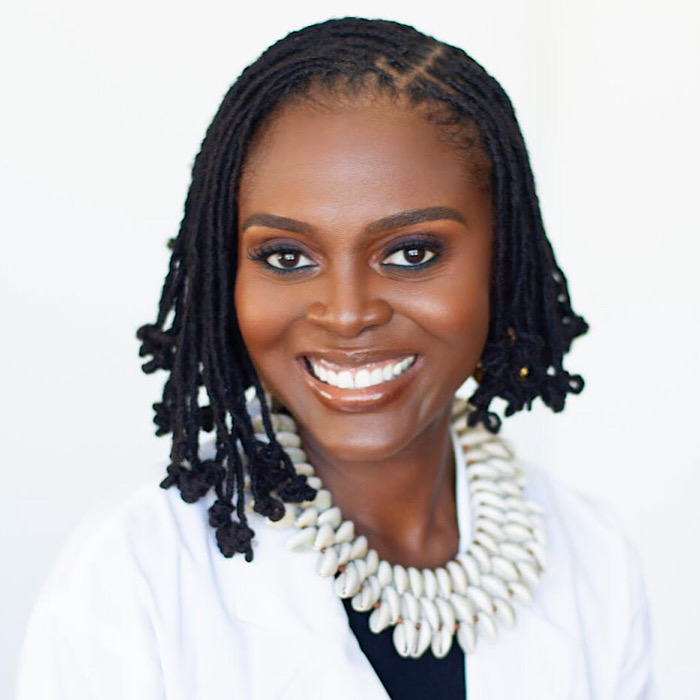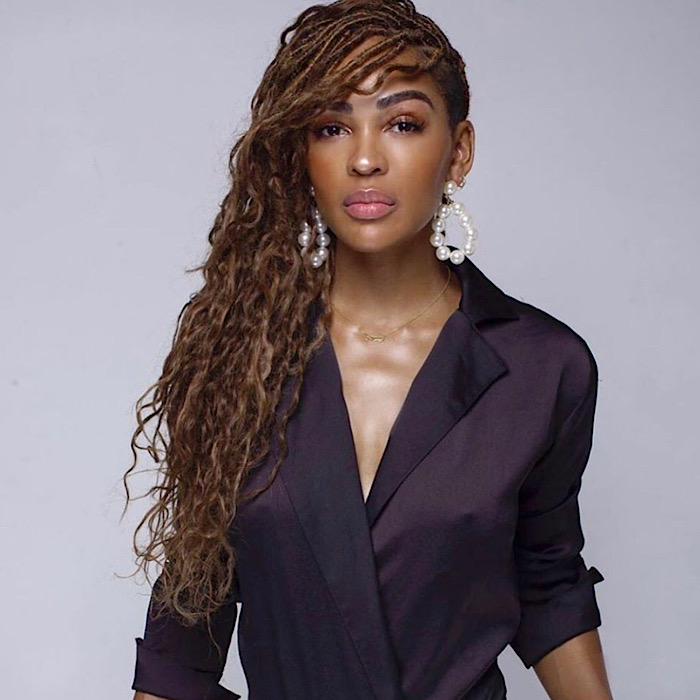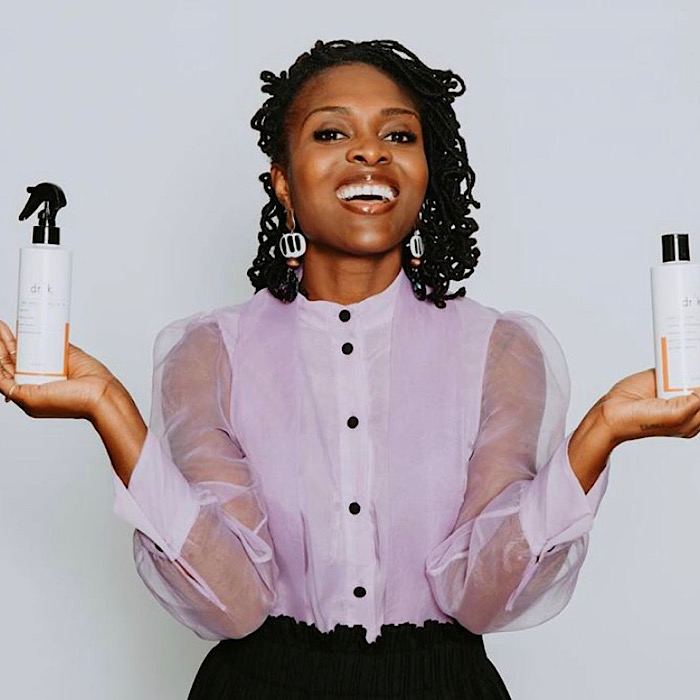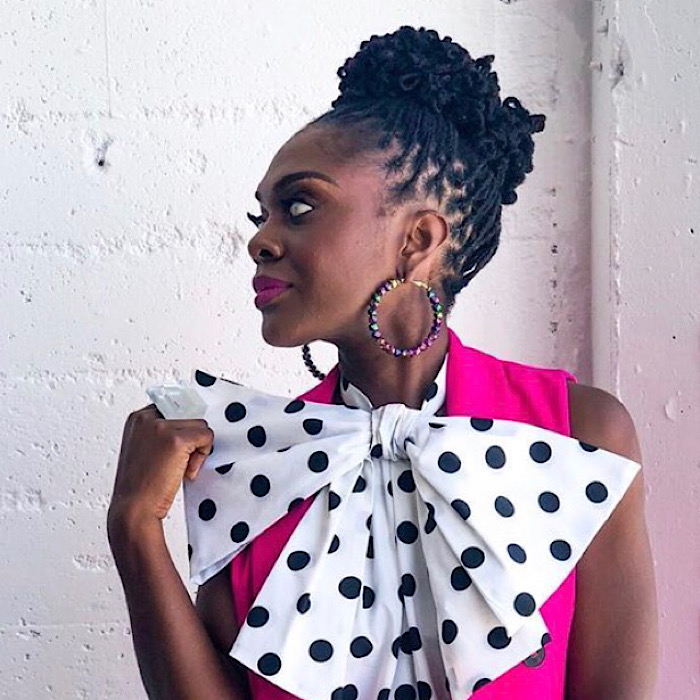Dr. Kari Williams is an L.A. native who juggles multiple glorious roles as a doctor of trichology, educator, and entrepreneur. As the creator of the Goddess Locs, she has continued to be an hair innovator in Hollywood working with celebs like Megan Good, Jennifer Hudson, and Chloe x Halle and behind the scenes teaching stylists how to be empowered in their craft. Managing Editor Alexandra Wilson chatted with Dr. Kari about the origin of her infamous goddess locs, her hair journey, and addresses the misconceptions of protective styling, and more!

Image: Dr. Kari Williams
Tell us about yourself and how you got involved in haircare:
I am a specialist in natural hair care and braiding. I have been doing it for over 20 years. I have always loved natural hair and the art of braiding and began to pursue it professionally when I was in college. I am a licensed barber and cosmetologist and I use that skill set to help men and women celebrate their hair in their natural state. Because of my natural gift as a braider I really focused on natural hair care and then combined that with my background in trichology which focuses on scalp and hair disorders. When I decided to develop an expertise in trichology, it was motivated by the fact that I wanted to help people who deal with hair issues like itchy scalp, hair loss, and breakage.
You have done so many different styles with various celebrities, how did you get into that industry and what inspired you to create the goddess locs?
There are so many stylists who aspire to be a celebrity stylist, but it was never a personal goal for me. I wanted to own a salon and serve as many people as possible. What I learned on my journey is that celebrities are people like you, who typically want services by people who reflect their values. Their values are professional, consistency, and having respect for their time. I was focused on being the best stylist I could be to serve any of my clients…and some happened to be celebrities. When I am training or working with a new stylist, it’s important that they feel empowered in whatever their craft may be and that they continue to reflect the values of the type of client they want to serve.
About five years ago we were in an era where faux locs were making comebacks and Megan Good’s stylist had contacted me saying she wanted faux locs but wanted them to resemble Lisa Bonet. This proved to be a challenge because Lisa Bonet’s locs are styled with her natural hair and not faux locs, but Megan really believed I could help her achieve this style. When it came time for me to have a final call with Megan I was asking God to give me the word to tell her I couldn’t do it and within that prayer God gave me the wisdom and insight to do it. After she hit the red carpet everyone was calling them faux locs and I decided it was time to brand this new hairstyle and then I came up with the name “Goddess Locs.” I love sharing this story with stylists because many of them don’t know that a young woman from South Central created them in addition to encouraging them to value their ideas. The biggest lesson I learned from this experience was learning to protect my ideas and not undervalue them.

It’s so important to own and brand your ideas, what was the trademark process like?
I don’t own the trademark which is why the origin of how they were created is such an important part of my journey. I underestimated the value of my creativity. As soon as I had created it I was teaching it to people and as it grew in popularity I realized that I needed to trademark it and protect it. However; alot of larger Asian hair manufacturers had already filed trademarks for the name. I currently have a patent pending regarding the technique. That inspired me to create a training platform that would allow me to teach other stylists how to protect their ideas and develop a sense of ownership within the hair space.
Tell us about your method and technique Goddess locs and what makes them unique
One of the defining characteristics of the goddess locs is the soft wavy ends and the original version of them was created with all human hair which keeps it lightweight and healthy. A lot of people who choose to wear loc extensions want longevity and the older they get the better they look. Using human hair allows for the natural hair to still remain healthy once the locs are removed after a 3-4 month period. Within the course I go into how to properly install the base. The goddess locs themselves are really two styles in one, you have a base that is created with a loc or twist and then you wrap it. The beautiful aspect of locs is that they are never the same so I teach stylists how to consult with their client on that process and make it unique to their natural hair texture. There are proper ways to wrap the locs so aren’t too heavy and then when removing them you won’t damage the hair.
Tell us more about Beauty By Dr. K and what was the process like?
The process was really fun! I’ve been working within hair care with other product lines for years and what I discovered in working with my clients is that they wanted products that were easy, simple, and would provide daily moisture. I started with listing the essential oils and ingredients that I knew would be beneficial hair with an emphasis on moisture. I approached my line from my trichology background and really just started to assess identifying the needs of my clients which came down to moisture and simplicity. I wanted to create a simple hair care system that helped build a foundation for healthy hair. We’ve gotten away from the simplicity of a good hair care routine.
I’m keeping it simple for you! We’ll be releasing my hair oil, then two shampoos (cleanse and clarifying”> and then a conditioner.

Let’s talk protective styles, what are the biggest misconceptions of wearing protective styles?
The biggest misconception I want to address is that because you have a protective style you don’t have to do anything, which is wrong, you need to wash your hair. Don’t neglect your hair or get rid of your hair care routine, you want to maintain it while in the protective style. I would also say don’t leave your protective style in too long because many protective styles are used with extensions. A protective style doesn’t require extensions, I define it as a style that gives you a break from daily manipulation like twists, cornrows, or braids with our own hair. Wearing extensions can increase the longevity of the style, but if you wear them too long it can cause alopecia or hair loss, particularly around the hairline.
What would you say is a good time frame for wearing a protective style like a passion twists, box braids, etc.
I would say 8 weeks, but around 4-5 weeks you want to get a touch up. A lot of the tension takes place around the hairline and over time as the hair grows out of the extension it becomes a weight and it pulls around the scalp. If you aren’t getting a touch-up I would say 6-8 weeks and anything longer than that should be discussed with your stylist.
We saw you participated in the campaign “Pretty Shouldn’t Hurt.” What are some myths of protective styles?
It’s a huge myth that in order for a braid to last it needs to be tight. I know many women who suffer through pain and tension and convince themselves that it’s necessary for a good style. There are so many Black girls and young women who are experiencing permanent hair loss. There are plenty of ways to create braids and use proper braiding techniques that keep a client’s hair healthy and void of tension.

There’s a misconception that by wearing protective styles that equates to hair growth, can you shed some light on this?
When it comes to tighter texture hair types, the hair is naturally fragile. When people are wearing protective styles they aren’t manipulating their hair for 4-8 weeks so it allows your hair underneath to grow which helps for length retention. I highly recommend protective styles for people with tightly coiled hair patterns have finer hair strands and wearing protective styles can help with lengthening the strand.
What are some easy protective hairstyles that people can do at home right now?
Cornrows, flat twists, two-strand twists, braids and bantu knots, are all great that are versatile and provide a combination two-in-one style. When you undo any of these styles you can take them out and rock a whole different style with added definition. It’s a great time to get to know your hair and love it so when you do get back in the stylist chair you can communicate what you want.
What do you recommend for dealing with an itchy scalp?
First it’s trying to determine what is the cause of the itchy scalp. I always counter this question with when did you last wash your hair? You may need to increase the amount of washing depending on your activity or hair thickness. If you have really thick hair make sure you are parting through and directly applying the shampoo to your scalp. If you are experiencing an allergic reaction or constant flaking make sure you are using a medicated shampoo and combining that with a deep conditioner.
Could you define some key indicators of someone having a scalp disorder vs. an itchy scalp?
If you experience thick flakes around the hairline that are scaling or that sit in the hair, redness, scalp texture changes, or inflammation that’s an indication you have a scalp disorder. Dandruff (powdery flakes”> are different because those can be a reaction from a shampoo or product you used.
What are your recommendations for building a scalp care routine?
It’s about making sure you are getting to the scalp. The biggest part of scalp care is keeping it clean and if it’s dry you want to use a light oil to keep it lubricated.
Can you clarify what’s a good lightweight oil for the scalp?
Jojoba oil is one of my favorite oils for dry scalp or flaking. Any of your essential oils are going to penetrate really well into the skin.
What’s your advice, to grease or not grease the scalp?
You don’t want to grease the scalp, I recommend using light-weight oils on the scalp because they will absorb into the scalp. Grease should be used on the ends of the hair to protect from the elements and friction.
Reading ingredients can be hard, what are some moisturizing ingredients we should look for when purchasing products?
The easiest moisturizing ingredients are water-based products, natural oils like jojoba, butters, and glycerin. These are all nice and hydrating ingredients that will absorb into the hair and scalp.
What are your recommendations for combing out locs?
If you want to comb out your locs you are going to go through a long process where you may experience some hair loss. The length of your locs won’t reflect the length of your natural hair because locs are an accumulation of hair that has shed from your scalp and is no longer attached. You also have to consider the amount of friction that will occur from combing your hair, you may need to consider getting a haircut afterward to get rid of any frayed or damaged hair. I recommend letting the locs grow out without retightening and then once the loc gets to a length you are comfortable with then cut them and start styling your own hair.
What are your tips for detangling matted hair?
You have to first determine how matted the hair is. The Dr. K Comb Out Cream is magic in a bottle! I have detangled a lot of hair and the key is patience and products. The Comb Out Creme is specifically formualated for that process to help make it easier. The longer you allow the product to saturate in the matted hair, it will be easier to comb through. Also, tools are key! Be sure you have a good comb, like a rat tail comb. Then, you will gently start seperating the hair from the ends and working your way up. Tangled and matted hair usually creates like a webbing, so if you’re patient enough and have the right product and tools you can get through the process.
